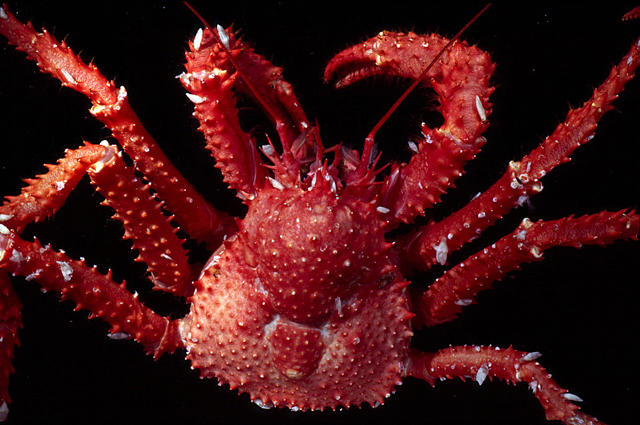Skeleton-breaking crabs expand into Antarctic
This post contributed by Nadine Lymn, ESA Director of Public Affairs
 Conjuring up a scene from a B-rated science fiction flick, new digital images show hundreds of king crabs moving closer to the sea stars, sea urchins and other bottom dwellers that have lived free from such predators in Antarctica’s coastal waters for 40 million years.
Conjuring up a scene from a B-rated science fiction flick, new digital images show hundreds of king crabs moving closer to the sea stars, sea urchins and other bottom dwellers that have lived free from such predators in Antarctica’s coastal waters for 40 million years.
Onboard the U.S. research vessel Nathaniel Palmer and the Swedish ice-breaker Oden, an international team of marine biologists sampled areas of the Bellingshausen and Amundsen seas to assess the status of crab populations in western Antarctica. Until recently, this region has been too cold for predators such as crabs, rays and sharks. As a consequence, the animals that live there lack defenses against such predators.
In their collaborative research project summary to the National Science Foundation, researchers Rich Aronson (Florida Institute of Technology), James McClintock (University of Alabama, Birmingham), Sven Thatje (University of Southampton) and colleagues note that “climatic cooling beginning in the Eocene eliminated durophagous [skeleton-breaking] fish and crustaceans from Antarctic waters. Since that time, the benthos has evolved toward an archaic, quasi-Paleozoic community structure in the absence of those top predators.”
 That community structure, as described by a February 8 Discovery article, resembles a “thick canopy of sorts, much like a submarine jungle comprised of flowery feather stars, tube worms and squirming sea spiders.” According to the researchers, that ecosystem and its inhabitants could be upended if the skeleton-crushing crustaceans reach it.
That community structure, as described by a February 8 Discovery article, resembles a “thick canopy of sorts, much like a submarine jungle comprised of flowery feather stars, tube worms and squirming sea spiders.” According to the researchers, that ecosystem and its inhabitants could be upended if the skeleton-crushing crustaceans reach it.
A key part of the international team’s assessment was towing an underwater instrument that took high-resolution images of the seafloor. Though they had suspected that warming water temperatures would enable king crabs to move from the deep ocean and up the continental slope, the researchers were surprised at the pace at which entire populations of the crustaceans are scrabbling closer to Antarctica’s shallow coastal waters.
Below a certain temperature, crabs are unable to process magnesium in their blood, which has a narcotic effect on them. This limiting factor is what has kept the crabs in the deep waters, which are actually slightly warmer than the Antarctic’s continental slope and shelf. The Discovery News article explains that “unlike most areas of the world, the shallower waters on the Antarctic continental shelf are actually slightly colder than the deeper waters of the Southern Ocean. That’s because of a clockwise current of water called the Antarctic circumpolar current. That flow of cold water keeps Antarctic marine life—especially the bottom-dwelling creatures—isolated.”
But as an article in The Antarctic Sun noted, the average winter temperature in the region has increased by 6 degrees Centigrade since the 1950s while the average ocean temperature has gone up by about 1 degree Centigrade.
 Thatje’s previous work, published in the Journal of Biogeography, suggested that temperature is a key factor in king crab distribution around the globe. As a 2009 ScienceDaily article about his research noted “With differences of only a couple of degrees in temperature affecting the distribution of the king crab, it is difficult to predict the consequences of range expansion in the warming waters around the Antarctic Peninsular region.”
Thatje’s previous work, published in the Journal of Biogeography, suggested that temperature is a key factor in king crab distribution around the globe. As a 2009 ScienceDaily article about his research noted “With differences of only a couple of degrees in temperature affecting the distribution of the king crab, it is difficult to predict the consequences of range expansion in the warming waters around the Antarctic Peninsular region.”
In the Discovery article, team member Aronson said that based on warming temperatures on the peninsula, one might have expected the arrival of crabs in another 40 years or so: “But boom, they’re already here.”
King crab photo credit: Sven Thatje
Stars and crab photo credit: Richard Aronson
Icebreaker Oden photo credit: Andrew Seaman